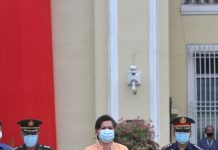by Lorie Ann A. Cascaro
TO protect Philippine banknotes, the people’s money, from counterfeiters, the Bangko Sentral ng Pilipinas (BSP) released the new generation currency last December. All six denominations: 20-, 50-, 100-, 200-, 500-, and 1000-piso were redesigned with better security features.
Compared to the new design currency (NDC), which is the preceding currency, the new generation currency (NGC) is “magical” and “a winner”, said Loida Cruz, assistant manager of the BSP central office’s cash department.
“Without the UV (ultraviolet) light, they look ordinary, but when lighted they are more magical than NDC,” she said, referring to the security fibers that glisten as exposed under the UV light.
These fibers, red and blue, are embedded in the paper at random and glow in two colors under ultraviolet light.
Common to all denominations of the new peso bills is the embossed prints, feel rough to the touch, like the words: “Republika ng Pilipinas” and “Limang Daang Piso”.
Aside from the embossed prints, serial numbers are composed of 1 or 2 prefix letters and 6 or 7 asymmetric (increasing in size) digits located at the lower left and upper right corners of the face of the note;
There is a see-through mark of the word Pilipino written in Baybayin (pre-Spanish Philippine writing system) seen in complete form when the note is viewed against the light;
The denominational value superimposed on the smaller version portrait at the upper left side of the note becomes obvious when the note is rotated 45 degrees and tilted down;
An embedded thread running vertically across the note is visible from either side of the note when viewed against the light.
Cruz noted the micro-printing that can only be read using magnifying lens, from 50-piso dominations and higher.
The optically variable device (OVD) and optically variable ink (OVI) are both included in the first level verification which can be seen with the naked eye.
OVD is a reflective foil that bears the image of the blue-naped Parrot and a small BSP logo in the 500-piso, while OVI is used in the embossed “1000” denominational value at the lower right corner of the face of the note that changes color from green to blue when viewed from different angles.
Does not hold water
Among the criticisms that BSP received upon dispatching the new generation currency, the blue-naped Parrot, which comments say always has a red beak, “does not hold water”, said Diwa Guinigundo, BSP deputy governor. The blue-naped Parrot can also have brown or white beak, he added.
There was also comment that the Philippine map on the reverse side of all denominations is 400 meters short in the actual map. However, “It is not wrong in scale,” Guinigundo said, but only used “to represent general locations of various iconic natural wonders in the Philippines.”
This criticism, he said, also does not hold water. If the BSP intended to print an actual map, he continued, measurements of altitudes and the like should have been there, as well as having exactly 7,107 islands.
With regards to the question of butanding (whale shark) on 100-piso as not an endemic specie in the Philippines, Guinigundo said “We are not saying that butanding is endemic and can only be found in Sorsogon. This regularly visits Sorsogon to mate and feed on planktons.”
Just as Alamid, local name for civet printed on 20-piso, is not only found in Banawe rice terraces, tarsier on 200-piso can also be found in Romblon and other regions, he said. “But, pag sinabi mong Bohol, chocolate hills: tarsier,” he added.
The two-word scientific names of the animals featured on the new generation currency are spelled capitalizing the first letter of both words. There was a comment that usually only the first letter of the first word should be capitalized.
But, Guinigundo said, “That’s our choice as exclusive issuer of currency… It’s part of our license, part of the artist’s license.”






